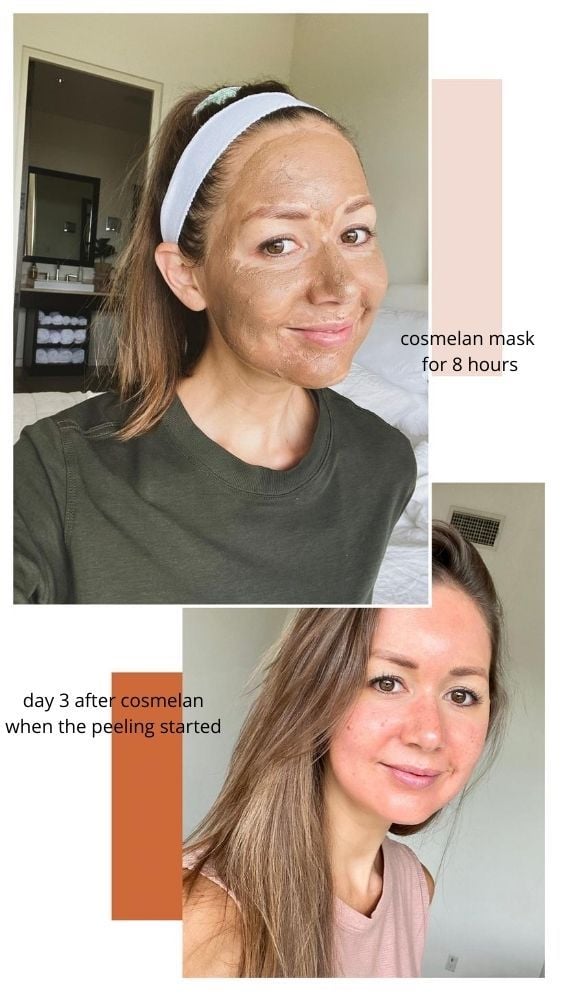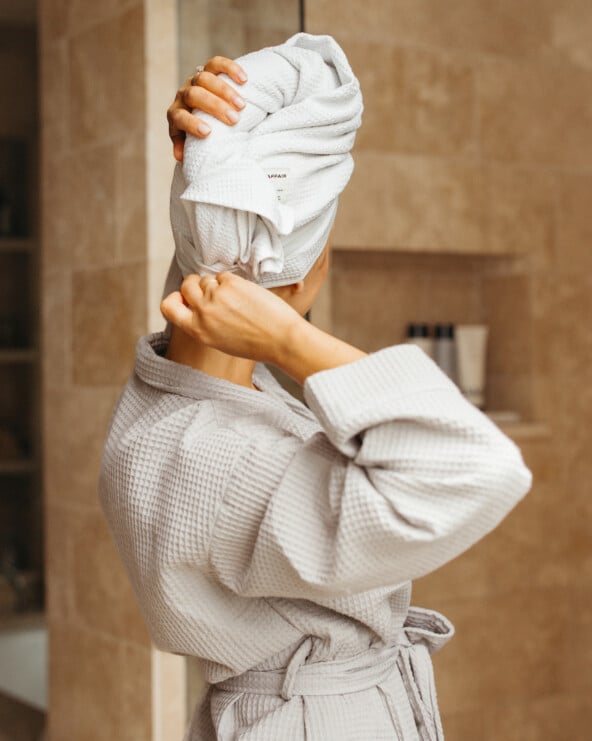Melasma is one of those things that no one warns you about before pregnancy but unlike morning sickness and sore boobs, it can hang around long after the baby has arrived. As in, permanently. Since I had never even heard of melasma before I developed it myself, let’s start with the basics. Melasma is when dark patches (hyperpigmentation) appear on the skin, usually due to hormones or sun exposure. It’s often on the forehead, cheeks, upper lip, and nose and can appear on the body, too. And to be clear, melasma definitely can happen outside of pregnancy; it just so happens to be especially common for pregnant women because of the hormonal fluctuations happening in the body. So, if this sounds like you, then keep reading for the best treatment for melasma.
During my first pregnancy with Phoebe, I didn’t develop melasma at all. In fact, I’d never had any issues with hyperpigmentation. But during the third trimester of my second pregnancy with Henry, I remember coming inside after swimming and doing a double-take when I caught sight of myself in the mirror. A noticeable brown patch had popped up on my forehead within a span of two hours. A quick Google search told me that I, in fact, was having a melasma flare-up. A chat with my dermatologist assured me that it would most likely fade away after my postpartum hormones balanced out, but that I should be particularly vigilant about sunscreen.
Flash forward to a year later, I stopped nursing, and while the melasma faded, it never really went away. As the years went by, it didn’t bother me too much, unless I accidentally got a little too much sun and it would suddenly flare-up. Until this summer when I went to my derm for a microneedling appointment, and in a shocked voice she cried, “Camille, what happened with your melasma?!” I hadn’t fully realized how much the situation had worsened this year (most likely due to a hormonal surge when I got an IUD in the spring), but it was bad enough where she couldn’t even do my treatment for fear that the radiofrequency could worsen it.
So, I decided to get serious and kick this melasma to the curb once and for all.
I talked through my course of action with Dr. Geddes-Bruce (and paired it with many hours of internet research) to figure out my plan. Turns out, melasma is known for being notoriously difficult to treat, but I’m happy to report: I did it.
So what is the best treatment for Melasma? Read on for three of the most powerful ways to treat melasma, which ones I tried, and what actually ended up working for me.
1. Topical treatment options for melasma
One search on Sephora will show that there are a lot of options when it comes to over-the-counter hyperpigmentation treatments. Some are aimed at halting pigment production by melanocytes (the cause of melasma), while others fade discoloration by lightening skin tone. Hydroquinone is often considered the gold standard by dermatologists for treating hyperpigmentation, but it is somewhat controversial (it’s been banned in some countries, but most docs in the U.S. agree that research studies don’t show that it presents a danger.)
I invested in two products that I used daily:
- Murad Rapid Age Spot and Pigment Lightening Serum — lightens with 2% Hydroquinone
- Counter+ No. 1 Brightening Facial Oil — reduces irritation and brightens with Vitamin C
Dr. Geddes-Bruce advised me to be very careful about “spot treating” with hydroquinone, since it will also get on the skin around the dark spot, too. She said that if I decided to go that route, watch for a light de-pigmented halo around the spot being treated. I never experienced this, but if I had, the next strategy would have been to apply a thin layer of product all over to evenly treat my entire face.
Over-the-counter hydroquinone products are available at concentrations of up to 2%. Anything higher than that requires a prescription. I used mine morning and night, after cleansing and before oil, so that the active ingredients could really penetrate. I also used the Brightening Facial Oil (great for pretty much all skin types, even if you’re not dealing with melasma) twice a day after the serum and before my moisturizer.
The verdict? Although I was skeptical that an OTC topical would make much difference, after a few weeks of use, I did see that the melasma patch on my forehead started to lighten—especially in photos, I could really notice a difference. That said, subtle improvement wasn’t enough for me: I wanted this bad boy gone. It was time to go for something a little more aggressive.
2. Oral treatments for melasma
I was surprised to learn about an extremely effective new-to-the-US market melasma treatment that is taken orally. Tranexamic acid has been proven to significantly improve melasma within a month, though it should be used as a short-term therapy (and some of the reports I read online said it can come back when the patient stops taking the medication.)
I was eager to try this wonder pill, but alas tranexamic acid can slightly increase the risk of blood clots, and since my IUD has the same side effect, they’re contraindicated.
3. In-Office Treatments for melasma
Many dermatologists are wary of treating melasma in-office since any type of inflammation (ie. lasers) can worsen the discoloration. However, Dr. Geddes-Bruce filled me in on one aggressive peel that she’s found to be highly effective: the Cosmelan Mask. It’s specifically formulated to reduce the appearance of skin discoloration brought on by hormonal imbalance and photodamage (aka the sun.) But it’s not for the faint of heart since it requires significant downtime. It turned out to be the one time that I was actually thankful for being self-quarantined at home! I signed right up.
On the day of my treatment, I went to her office for a quick application of a mud-like mask that I had to wear for eight hours—and yes, I had to wear it out of the office and in my car on the way home. My children were intrigued.
That night, I washed it off in the shower, and then for the next 14 days, applied an at-home mask daily to continue encouraging cell turnover. And boy did those cells turn over. By day two, my skin looked sunburnt, and by day four, it started flaking off… which continued for the next 10 days. It was itchy and annoying to not be able to wear makeup, though I did turn a corner when Dr. Geddes-Bruce told me that I could actually be applying moisturizer liberally (which I hadn’t realized.) I started slathering on my most comforting hydrator, Milk & Honey’s Blue Tansy Balm, which felt like a comforting hug for my face and majorly reduced the irritation.
On day 15, the peeling stopped, and suddenly I was left with the evenest, glowy skin that didn’t even need makeup. My melasma was gone, people. And on top of that, my skin texture was smoother and looked all around healthier.
Dr. Geddes-Bruce reminded me that melasma is basically a chronic condition that will require a bit of maintenance to keep it at bay. My plan is to spot treat with my hydroquinone three to five days a week in the summer whenever it starts to flare up and take it down to one to two days a week in the winter months. I have zero regrets and am so thrilled with the results, but boy was it a journey—one I hope never to have to repeat which is why I’ve become more vigilant than ever with my daily sunscreen. And on days when I’m going to be in the sun, I’m never without my hat and sunglasses.
***
Have you guys dealt with melasma? I’d love to hear your experience in the comments!
Oh, and don’t think I’d leave ya hanging without an after pic… note the sun hat.








